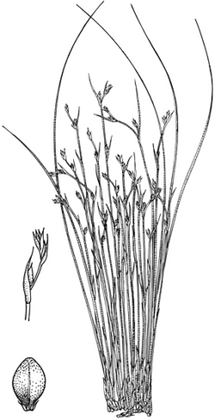Tricostularia pauciflora (F.Muell.) Benth. APNI* Synonyms: Lepidosperma pauciflorum F.Muell. APNI*

Description: Small tufted perennial.
Culms 1-noded or nodeless, terete, glabrous, yellow-green, 10–45 cm high, 0.5–1.2 mm diam.
Leaves often much reduced, to 6 cm long; sheath straw-coloured to dark red-brown, dull. Spikelets solitary or 2 or 3 in a terminal cluster (rarely a second distant cluster), terete, 4–6 mm long, each spikelet with an uppermost bisexual flower and lower 1 or 2 male, sterile or bisexual; involucral bract somewhat shorter than inflorescence. Glumes subdistichous, long-acute to acute, keeled especially near apex, glabrous except for occasional hairs on keel, very pale red-brown to very dark red-brown (apex often darker than body); fertile glumes 3.5–4.0 mm long. Scales minute, whitish. Anthers c. 1.5 mm long.
Nut obscurely trigonous, obovoid to obpyriform, 2.2–2.5 mm long, 1.2–1.5 mm diam., puberulous especially near apex, dull, mid- to dark brown.
Flowering: spring–summer.
Distribution and occurrence: Grows in swampy places mainly in coastal areas; rare (or rarely collected?) on the North Coast, more common in SE coastal NSW, extending inland to Gibraltar Range and the Blue Moountains.
NSW subdivisions: NC, CC, SC, NT, CT
Other Australian states: Vic. Tas. S.A.
Text by K. L. Wilson 1993 (edited June 2020)
Taxon concept: Flora of NSW 4 (1993)
APNI* Provides a link to the Australian Plant Name Index (hosted by the Australian National Botanic Gardens) for comprehensive bibliographic data
***The AVH map option provides a detailed interactive Australia wide distribution map drawn from collections held by all major Australian herbaria participating in the Australian Virtual Herbarium project.
|


